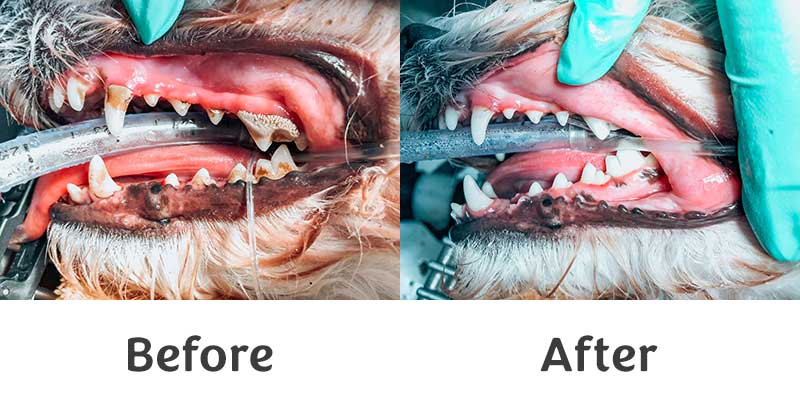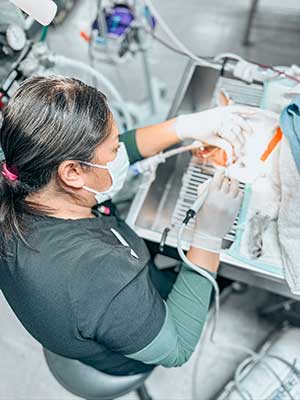Did you know that 80% of dogs and cats are estimated to have some form of dental disease before the age of three?
When you analyze the situation, this might not be as far-fetched as it seems. How often do you brush your teeth? Probably every day. And how often do you have a dental cleaning? Probably once every six months to one year. Now, how often does your pet have their teeth brushed, and when was their last dental cleaning?
This is why veterinary dentistry is an important, although often overlooked, issue. Just like human teeth, the teeth of your pets can decay and cause them pain.
Keep your eyes, and nose, peeled for these signs of dental disease:

Step 1
Schedule a dental consult or talk with your veterinarian at your next visit about a dental assessment. A veterinarian will survey the teeth and gums, and determine if dental disease has occurred, and the extent of the damage. At that time they can give recommendations and even provide you with an estimate if a dental cleaning is needed.
Step 2
Once you have decided to get your pet's teeth cleaned, we will schedule your pet to have their pre-surgical bloodwork completed before the procedure day. Pre-surgical bloodwork is important in ensuring your pet is healthy enough to undergo the procedure.
Step 3
The day of the dental cleaning has arrived!

All of our patients receive general anesthesia for their dental cleanings. This is the only way to accurately perform a full oral exam in order to address problems areas, such as below the gum line and teeth further back in the mouth. We perform full mouth x-rays that allow us to see areas of concern not seen by the naked eye. X-rays are crucial in evaluating the health of the teeth roots, while identifying potential damage located below the gum line that may affect the bone structure of the jaw and surrounding tissue. In some cases, if decay has progressed to an extensive point that is causing your pet pain, oral surgery may be necessary. Our surgical team has the experience and knowledge necessary to perform a safe and effective procedure that will prevent the spread of dental infection to other areas of the mouth or body.

We will use an ultrasonic scaler to thoroughly remove plaque build-up from the teeth. This is followed by polishing to remove any remaining plaque. Then, the teeth are rinsed.
Step 4
After the cleaning, we will chart your pet's teeth to create a record of their health and progress. This will allow us to look back at previous dental cleanings to monitor any changes. Your pet is closely monitored during each stage of this process to ensure they are safe and comfortable.
Step 5
Once awake, your pet will be placed in a recovery cage until they are ready to go home. Our highly trained technicians will be monitoring them closely to ensure they are comfortable during the entire recovery process.
Step 6
The veterinarian will call you to go over all aspects of the procedure and relay any important information and/or recommendations. Upon picking up your pet, the surgery technician will go over any discharge instructions. You're free to go home and enjoy all those fresh breath kisses!
Located in the South Lamar neighborhood in South Austin. Directly off of US-290 between Bluebonnet and Oltorf.
Phone: 512-448-2676